The Impact of Column Hardware on Efficiency in Liquid Chromatography (LC)
Column hardware in liquid chromatography—that is, the tubing, the frits, and fitting—has a strong influence on separation performance or the reproducibility of chromatographic data. Flow distributors and frits can introduce serious band broadening when separation is performed in short, narrow-bore columns. The kinetic performances of packed and monolithic columns are usually similar for well-retained analytes. However, monolithic columns may show significantly better performance for early-eluting compounds, which can be attributed to the moderate mobile phase dispersion caused by the simpler column hardware because no frits are required.
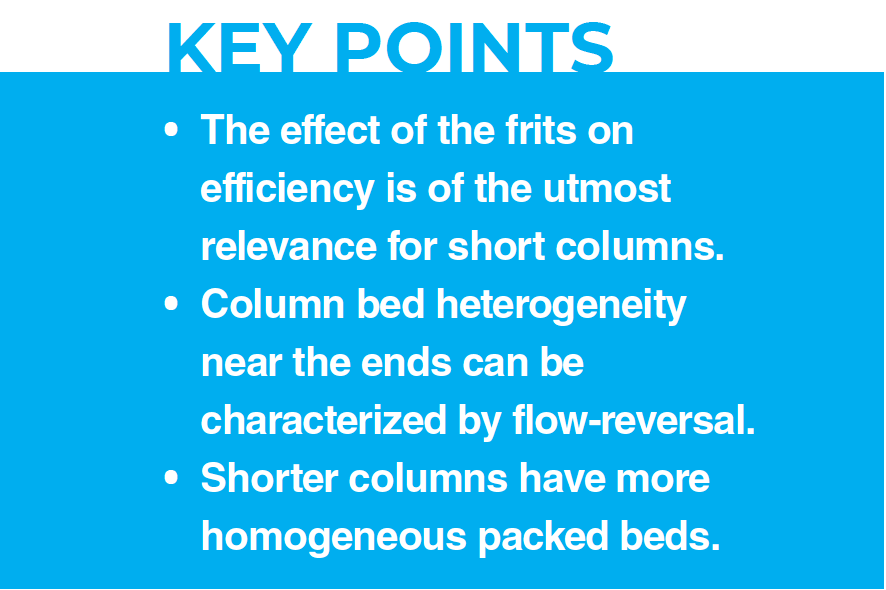
Packed columns are axially heterogeneous, and some differences can be observed between the two respective column ends as a result of the packing procedure. The sample band broadening in the immediate vicinity of the column ends can be characterized with flow‑reversal experiments. Although flow‑reversal has a peak compression effect, and the peaks observed with reversed flow are always narrower and more symmetrical than the peaks obtained without reversing the flow, flow‑reversal can be a useful tool to show the differences between the intrinsic plate heights of the packed or monolithic bed and for showing the differences between the two respective column ends. Shorter columns are axially more homogeneous than longer ones, thus the column length is an influencing factor on the column packing procedure.
As a result of the smaller particle sizes (sub-2-µm), particle structure, and narrower column hardware, the new generation of liquid chromatography (LC) columns produce much sharper and narrower peaks than earlier generations. With the reduction of the peak volume, it was also necessary for manufacturers to improve the instrumentation technologies to minimize the extra-column dispersion effects (1).
The band variance of a poorly retained peak is a few µL2 for the very efficient 2.1 × 50 mm narrow-bore columns, whereas the extra-column band broadening caused by a typical modern instrument can be up to 5–40 µL2 (2). Therefore, an innovation is required to achieve appropriate efficiency and the system dispersion must then be minimized by improving the different parts of the ultrahigh-pressure liquid chromatography (UHPLC) systems (the injector, the connecting tubes, the detection cell) (3–5).
Usually the dispersion caused by the extra-column band broadening effects is studied and discussed, although the extra-bed on-column broadening also needs to be mentioned separately from the band broadening caused by the stationary phase itself. This effect comes from the presence of porous frits at the column ends, which causes dispersion of analytes and bubble formation (1,6,7). The role of the frits is to hold the stationary phases within the column and pass the eluent through freely. Many solutions have been sought to minimize the dispersion caused by the frits, but the effect of the frits seem to be the least studied contribution to band broadening. A helpful review article has been published by Cheong for fritting techniques or fritless techniques in chromatography (8).
Nowadays, for example, for the commercially available 2.1 × 50 mm columns packed with 1.6 µm superficially porous particles (SPPs) the reduced plate height is 1.45 (9). After the correction for the dispersion due to the inlet and outlet frits, the intrinsic reduced plate height of the packed bed is 0.75, which is close to the theoretical minimum reduced plate height. Consequently, a significant part of the efficiency is lost because of the dispersion of the two column end frits (9). Therefore, it is important to accurately determine the effect of the frits on band broadening.
Broyles et al. examined the impact of the diameter, thickness, and porosity of the frits on the shape of the migrating solute band in a 17 × 100 mm column, using multi‑aspect visualization. Various frits were tested, a clear impact on separation efficiency was identified, and the authors concluded that “the ‘art’ associated with packing columns can also be extended to encompass the ‘art’ of frit selection and manufacture” (10,11).
The Flow-Reversal Method
The flow-reversal method has been discussed in the literature for some rare cases. It was used for the demonstration of the degree of distortion of the hydrodynamic flow profile in columns for preparative LC and, for example, to establish the theoretical plate heights of chromatographic columns prepared by stacked membranes (12–14).
For the evaluation of the band broadening that occurs at the different sections in the chromatographic column the flow-reversal method can be used (7). The method includes the arresting of the mobile phase flow when an unretained marker has migrated a given penetration distance into the column, and the reversal of the column under the parking time when the flow is arrested.
The role of the axial diffusion (Deff) characterizing the sample band broadening can be examined by peak parking experiments. From the extent of band broadening during the tpark parking time, the effective axial diffusion coefficient can be calculated (15–17).
When the flow has been restarted, the sample elutes at the same column end where it entered the column. According to the procedure, the sample band passes twice through (inward and outward) the same column end, and travels twice through the given column distances. The schematic arrangement of flow-reversal is shown in Figure 1.
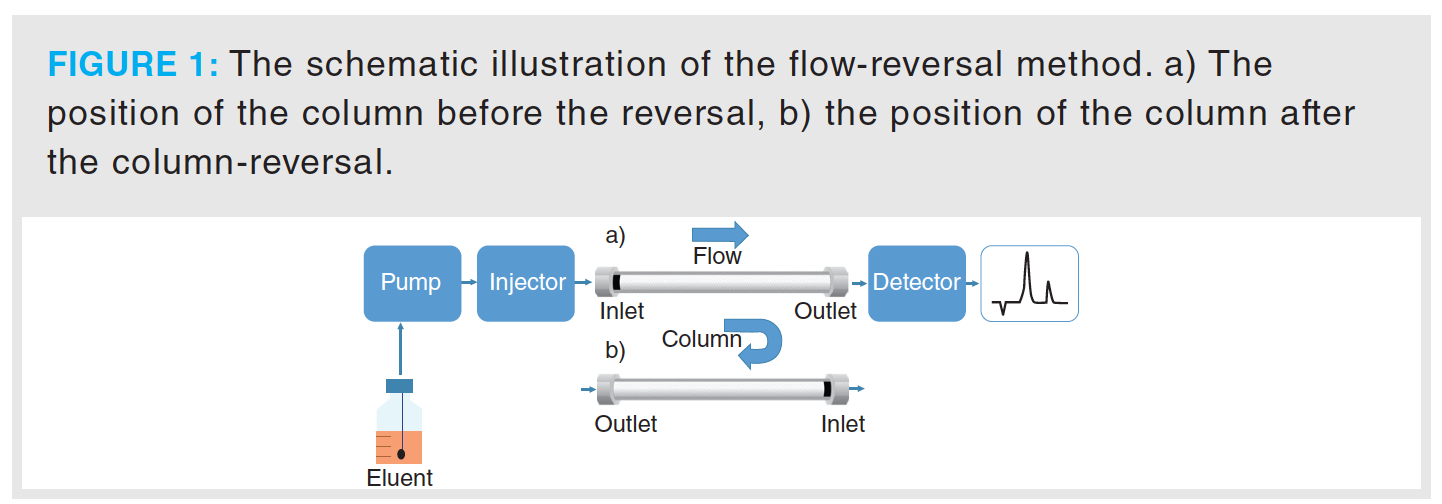
Theoretically, if the column is axially homogeneous and the column inlet and outlet are identical, one can observe similar band broadening in each direction, therefore the plots of the band variance against the distance that the sample penetrates are linear with the same slope and intercept. Due to the nature of the column packing procedure, one may assume that the inlet and the outlet ends of the columns exhibit a different structure and efficiency, thus experiments should be carried out to test either the column inlet or the outlet.
Overview of Flow-Reversal Method Results
Recently, Gritti et al. have designed and built a low‑dispersion system made of two 50‑nL optical detection cells placed immediately before and after the column to increase the accuracy of the plate height measurements. They applied the flow‑reversal technique to examine radial and axial structural heterogeneities of packed column beds. They found that a significant peak refocusing was observed when reversing the flow direction, which confirms the existence of long-range velocity biases in packed chromatographic columns. Their results confirmed that the inlet region of a packed column is more uniformly packed than its outlet region when it is reversed‑packed (6).
Lambert et al. (7) examined the effects of the column end (frits and their environments) and the bed heterogeneity of packed and monolithic columns with the flow‑reversal method. Monolithic columns show rather similar performance at either column end, whereas the two respective ends of packed columns can exhibit even 20–25% difference in efficiency (see Figure 2).
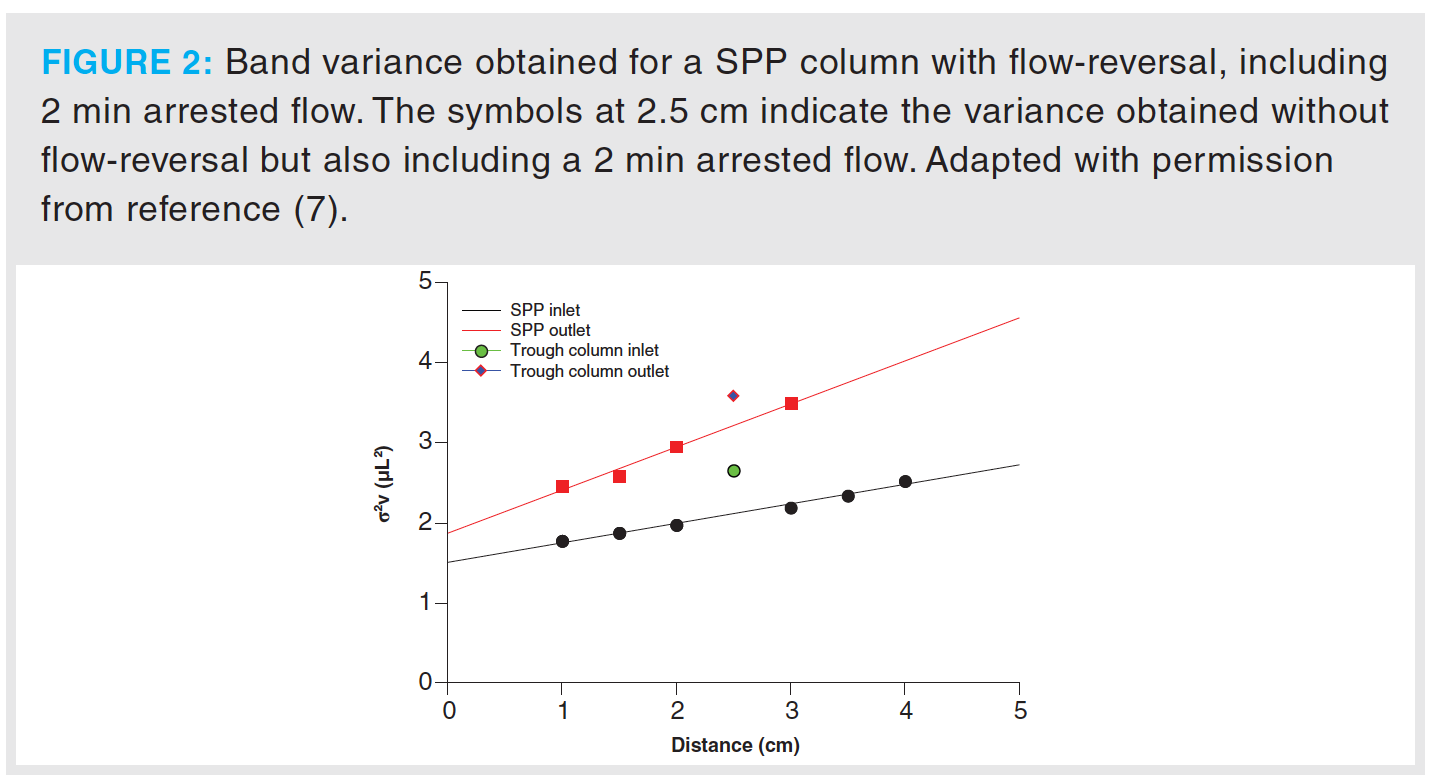
For an unretained marker in a well‑packed column, the band broadening occurring in the homogeneous stationary phase bed and in the end‑structure of the column are almost identical. The best performing column was the monolithic column tested that provides sufficient efficiency at moderate pressure drop (7). That column shows significantly better performance for early eluting compounds, which can be attributed to the rather small mobile phase dispersion caused by the simpler column hardware: no frits are required (see the circle symbols in Figure 3). The monolithic column will show similar properties to the packed columns for the entire range of retention factor when commercial frits are attached at both ends of the column (see the square symbols in Figure 3).
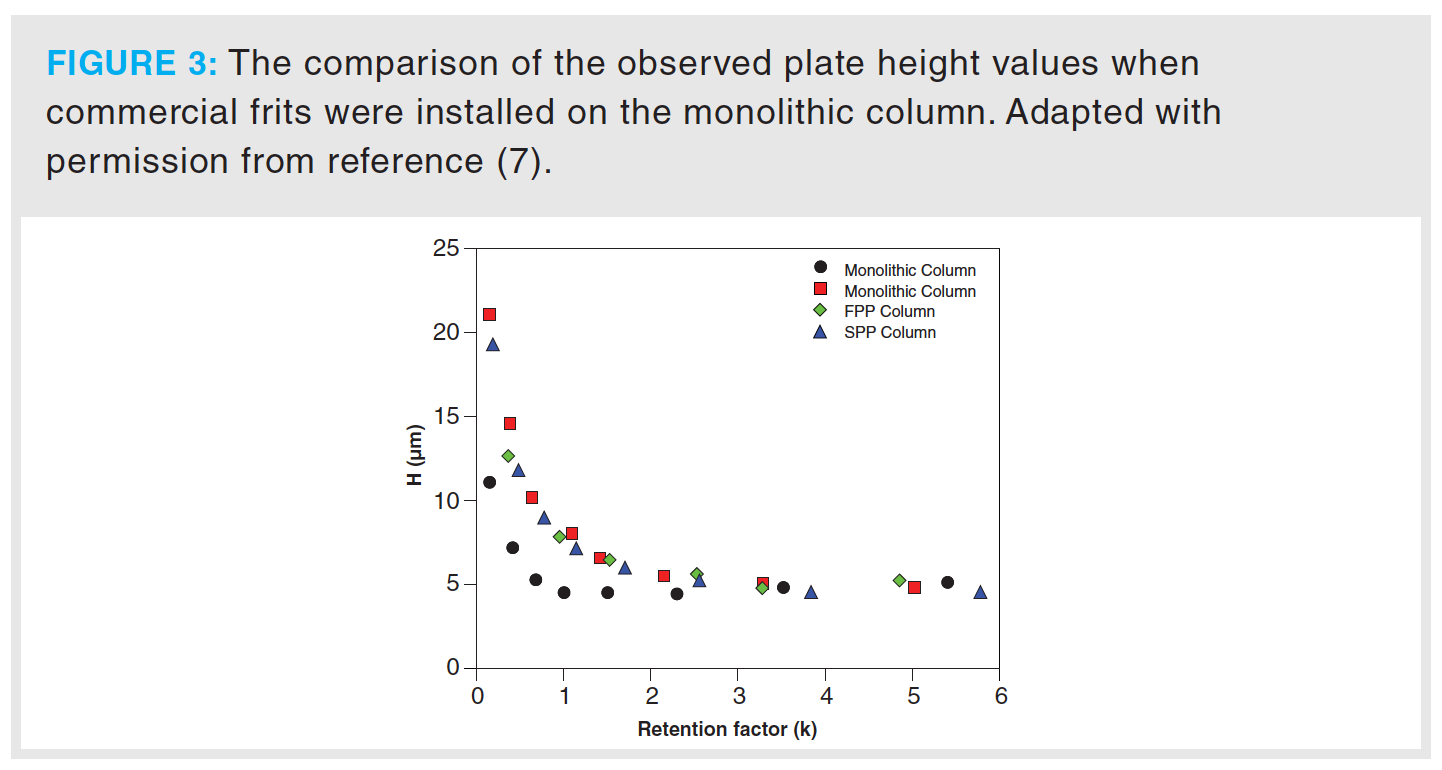
Furthermore, the extra‑column band broadening in the UHPLC system is also nearly the same as either of the aforementioned contributions. Two‑thirds of the column efficiency is lost because of dispersion in the frits and in the equipment. The 5‑cm‑long column bed causes the same amount of band broadening as the 2 × 1 mm frits. Thus the uncorrected plate number for an unretained analyte is only 33% of the efficiency of the well‑packed bed itself, even if the best equipment—with the smallest system volume (without switching valves, and with a 0.0025 i.d. peek detector capillary), where the extra‑column band broadening is 1.059 µL2—is used.
One can observe the peak compression effect of flow‑reversal in Figure 4. The peaks observed with reversed flow are always narrower and more symmetrical than the peaks obtained without reversing the flow. This phenomenon can originate from the compensation of the multipath dispersion effects when one assumes that the molecules mostly travel through the same interstitial channels inward and outward through the column (7,18).
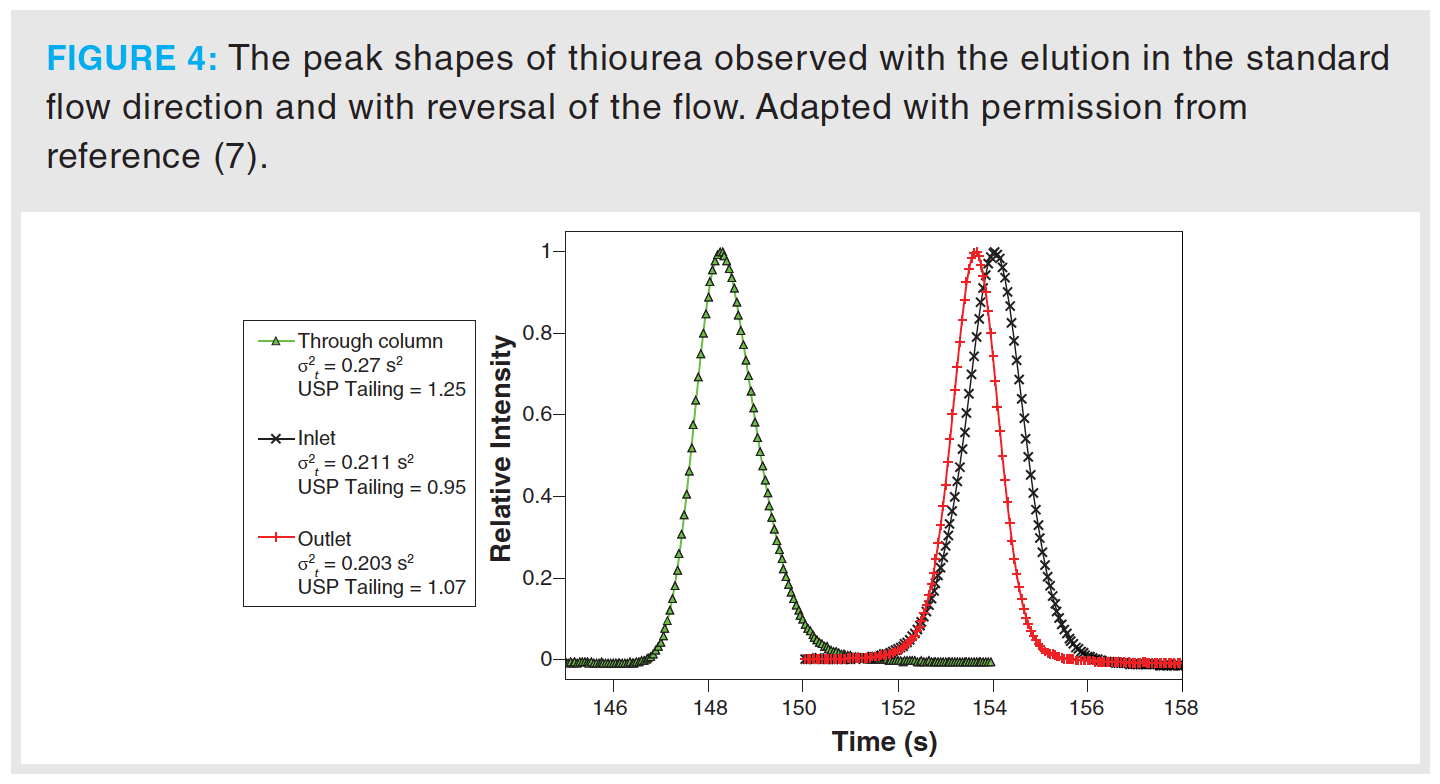
Zelenyánszki et al. (19) examined and compared the kinetic performance of series of 2.1 × 50, 100, and 150 mm columns packed with fully and superficially porous particles. The superficially porous particle columns provide slightly greater plate height values at the optimum mobile phase velocity (except for the 15‑cm‑long column). To illustrate how the flow‑reversal method can be used to characterize the sample zone broadening, the differences between the forward and backward measurements, that is, the differences between the respective column ends are presented in Figure 5, for the testing of the 5‑cm‑long fully porous particle (FPP) column against the penetration distance run parallel, which indicates that the intrinsic plate heights are identical—H = 2.7 µm—regardless of the flow direction in the column (19).

The local plate height values were found to be smaller with flow‑reversal than with arrested flow, due to the compensation of the multipath dispersion effect and radial flow profile heterogeneities.
The efficiency at the respective column ends and the efficiency of the packed bed—that is, the local plate heights—differ from each other for each column; the columns are axially heterogeneous, but the difference is negligible, and one cannot be sure whether the column inlet or outlet performs better. The local plate height increases with increasing column length. Comparing these local plate heights to the overall column plate heights, one can establish the effect of the frits and the column end structure near the frits, which are larger for the SPP columns (see Figures 6 and 7). Furthermore, one can conclude that shorter columns can be packed with better bed efficiency. The results show that the column length has an influence on heterogeneity and the shorter the column, the more significant the effect of the frits is.

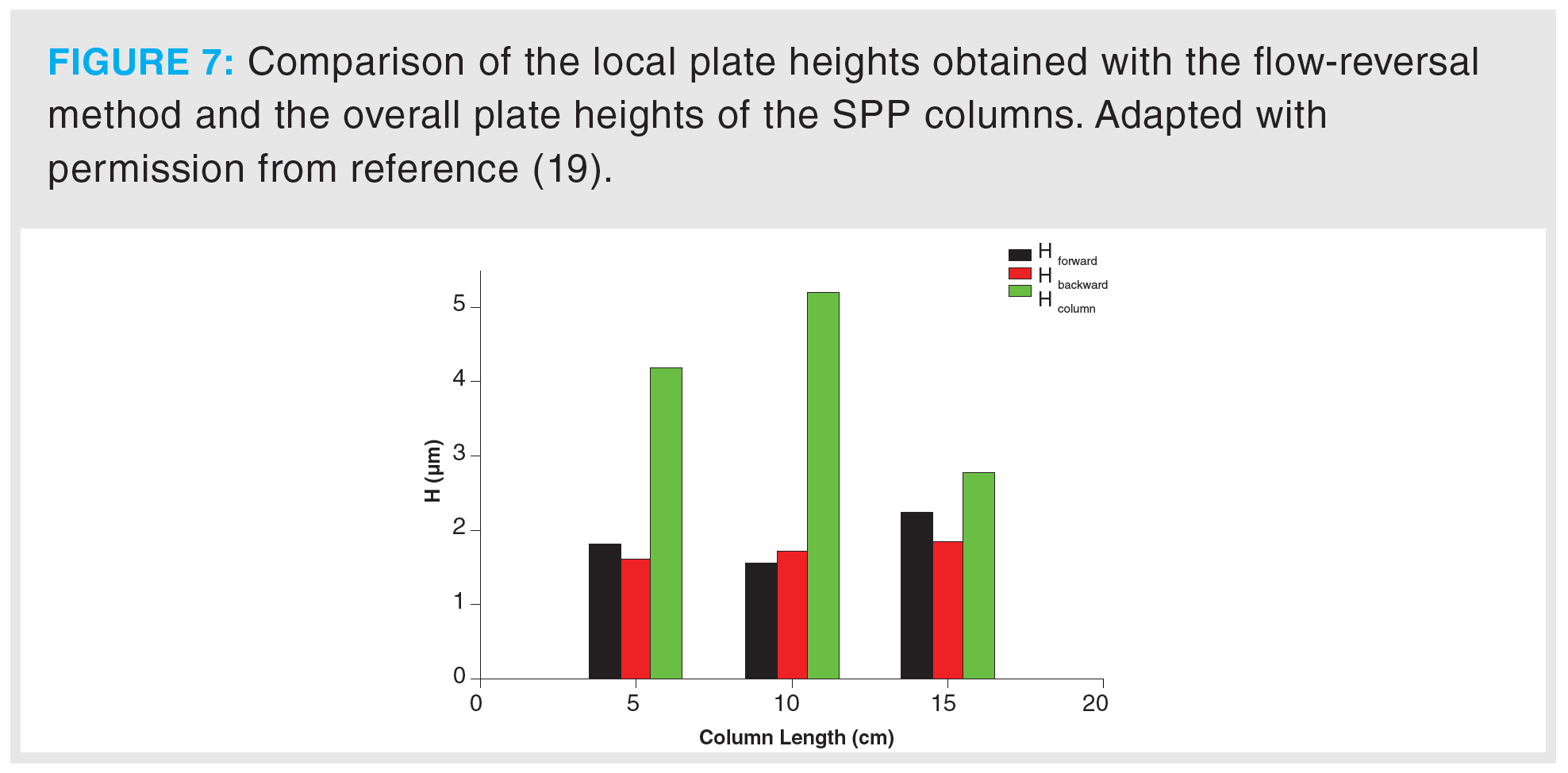
Accordingly, although the packed beds in shorter columns are more homogeneous and the local plate heights are smaller for short than for long columns, the overall efficiency of the short columns is worse than that of the long columns since the relative contribution of the frits is more substantial for short columns (19).
In another study by Zelenyánszki et al. (20) the peak parking and flow‑reversal measurements have been expanded to macromolecules and carried out with human insulin. The insulin peaks observed after flow‑reversal are, again, narrower and more symmetrical than the peaks obtained without reversing the flow (see Figure 8). For small molecules, such as thiourea, the band compression effect was found to be less (6,7). The molecular diffusivity of macromolecules is much smaller than that of small molecules. Thus, the radial heterogeneity of the packed bed affects to a larger extent their migration and thus, a larger band compression effect can be observed for macro‑molecules when the flow is reversed.
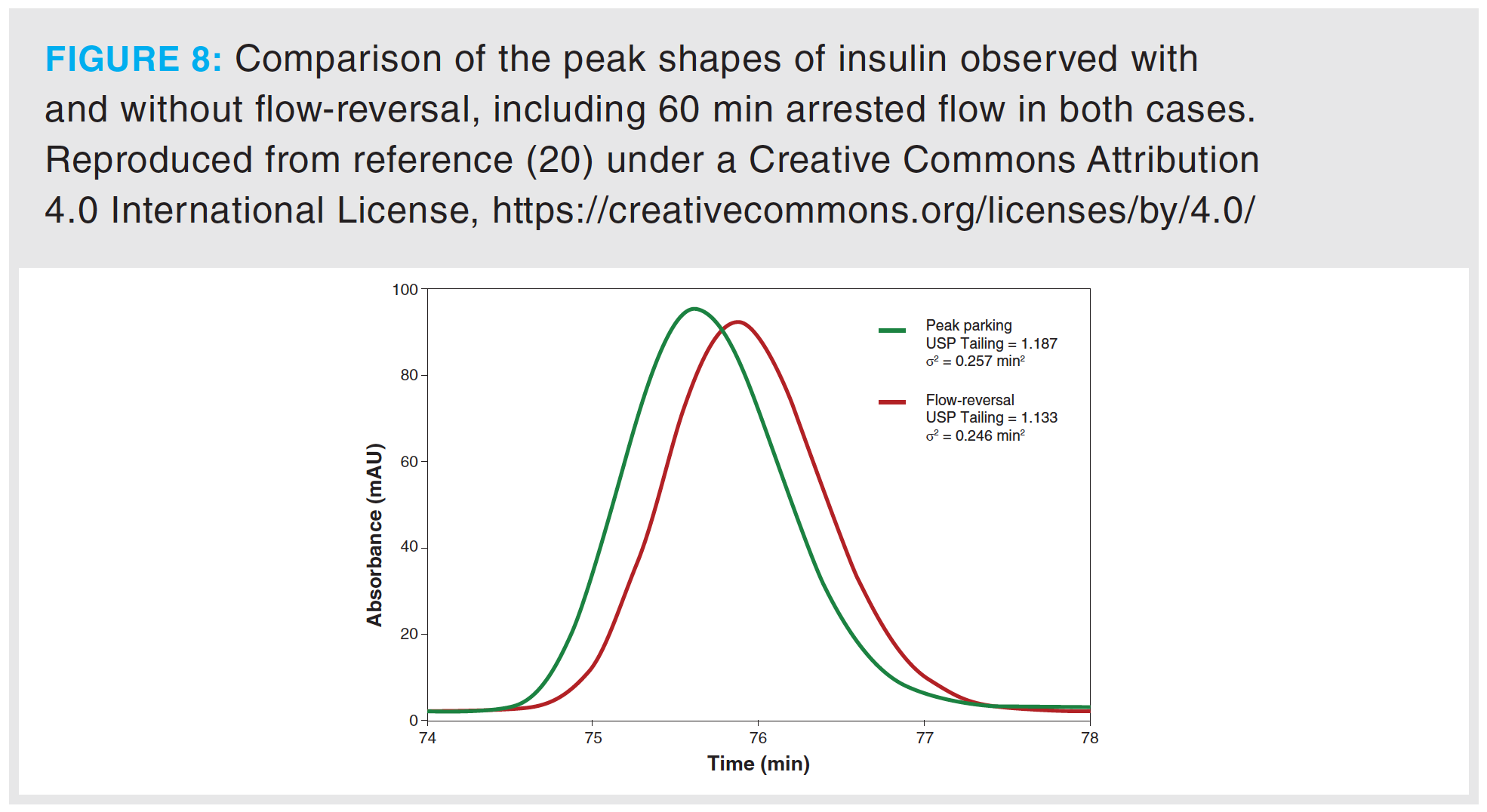
The contributions of the column inlet and outlet to the total band variance have been determined successfully, when using the column in forward or backward direction and injecting unretained macromolecules. With the injection of insulin, the differences between the two respective column ends and the influence of flow direction on the local plate heights of the homogeneous column bed can be determined using the flow‑reversal experiments (20).
Due to the Taylor–Aris dispersion, the experimental conditions for macromolecular analytes should be significantly modified compared to the tests with small molecules. Flow‑rates should be rather small so that solute molecules have time to diffuse the entire cross section of the system capillaries. Mobile phase flow should be arrested for 60 min before reversing the flow due to the rather small molecular diffusivity of insulin. Therefore the experiments become much lengthier than with the thiourea or other unretained small molecules (20).
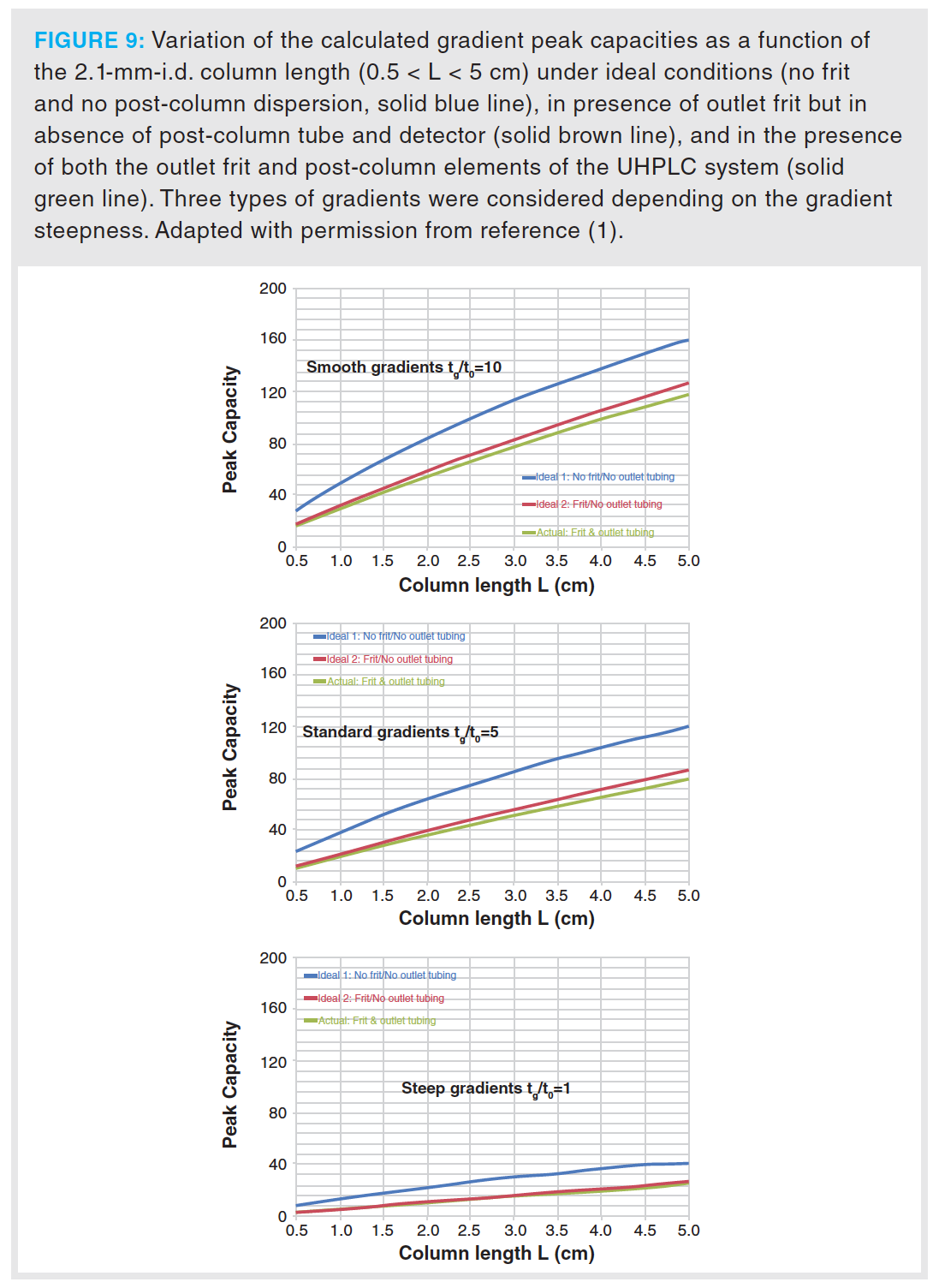
Gritti and Gilar have recently studied the impact of frit dispersion in gradient elution chromatography (1). They found that the presence of the outlet frit has a serious limitation on the accessed efficiency (Figure 9). Thus, there are several facts confirming that frit technology should be seriously revisited (1,6,7). As one can see in Figure 10, voids are observed at the circular joint between the stainless steel frit and the metal ring, and in the central region of the frit showing some damages and defects (revealing stainless steel grains and circular marks) (1).
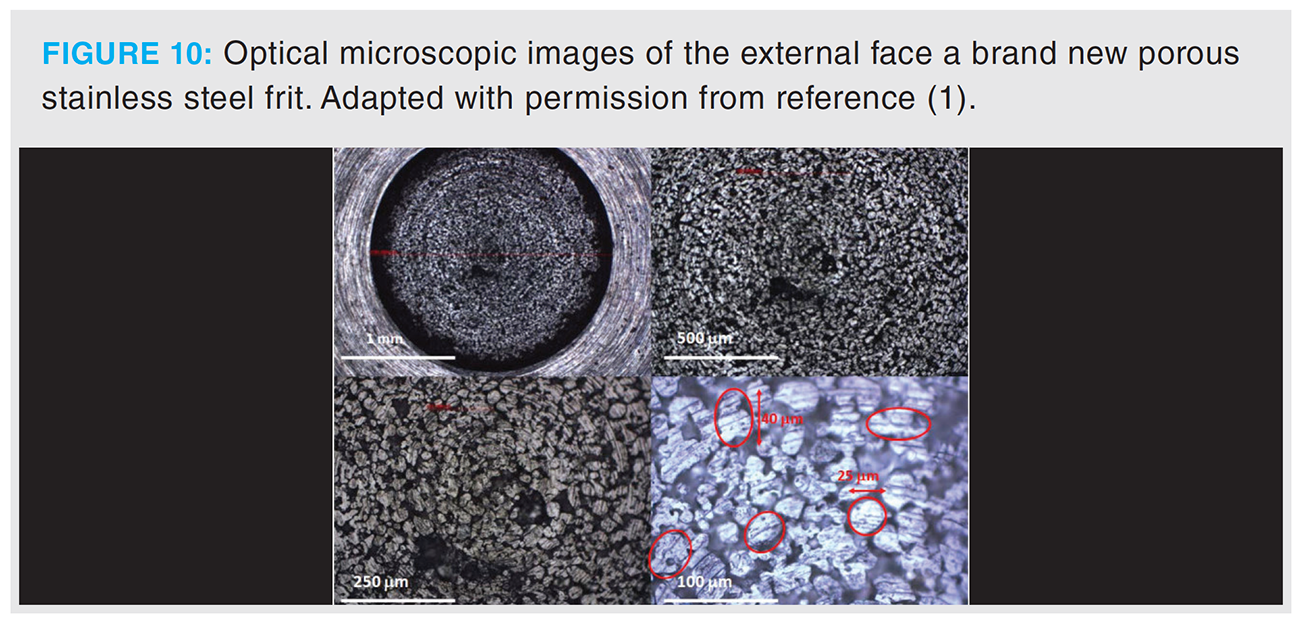
Electron Microscopic Measurements
Frits from different disassembled columns have been investigated with scanning electron microscopy. The purpose of these measurements is to find any damage on the frits due to the effect of the column packing procedure. The examination of the inlet and outlet frits of five different columns did not show any visible damage on any of the frits, but the impacted silica particles are clearly visible in the pores of the frits (see Figure 11). These impacted particles are also responsible for the band broadening effect near the frits. Figure 11 shows that there is no sharp boundary between the column packing and frit. Particles randomly penetrate in the macropores of the frit. There is a large contact surface between the particles and the frit, and the mixed zone on the inner frit surface, as well as the pore structure of the frit induces a momentous dispersion.
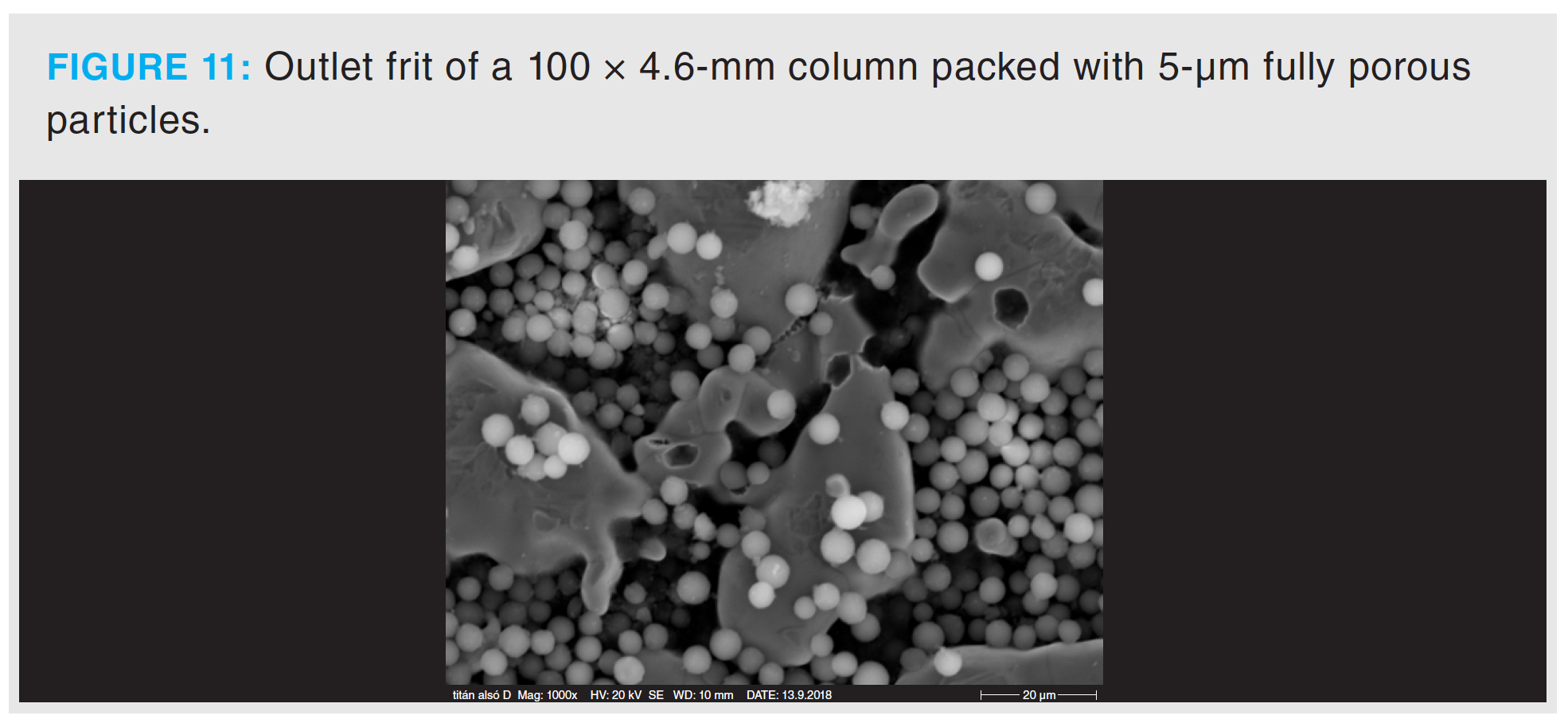
Conclusions
The impact of column hardware on efficiency in LC can be determined via flow‑reversal experiments. The dispersion in the frits composes a significant part of the band broadening for modern narrow‑bore columns. Therefore, frit technology needs serious improvement, and there are several ways to do that. The frit volume can be reduced by its thickness (1) or the disk‑like shape of the frit can be modified from a flat surface to a curved one. Gritti et al. suggested the use of conical columns instead of the currently‑used cylindrical columns so the outlet frit diameter, and consequently the dispersion the frit causes, can be small (21).
As the scanning electron microscopic images demonstrate, the internal macroporous frit structure is heterogenous and disordered. In the near future, 3D-printing technology may offer a solution to this problem (1).
Acknowledgements
The work was supported by the NKFIH OTKA grant K125312. The work was also supported by the ÚNKP-19-3-I-PTE-119 New National Excellence Program of the Ministry of Human Capacities. The authors thank Waters Corporation for the generous gift of the columns used in the experiments. The authors are grateful to László Seress and Hajnalka Ábrahám (Central Electron Microscope Laboratory, University of Pécs) for the electron microscopic measurements.
References
- F. Gritti and M. Gilar, J. Chromatogr. A 1591, 110–119 (2019).
- F. Gritti and G. Guiochon, J. Chromatogr. A 1327, 49–56 (2014).
- F. Gritti and G. Guiochon, J. Chromatogr. A 1218, 4632–4648 (2011).
- F. Gritti, T. McDonald, and M. Gilar, J. Chromatogr. A 1420, 54–65 (2015).
- G. Desmet and K. Broeckhoven, Trends Anal. Chem. 119, 115619 (2019).
- F. Gritti, M. Dion, A. Felinger, and M. Savaria, J. Chromatogr. A 1567, 164–176 (2018).
- N. Lambert, S. Miyazaki, M. Ohira, N. Tanaka, and A. Felinger, J. Chromatogr. A 1473, 99–108 (2016).
- W.J. Cheong, J. Sep. Sci. 37, 603–617 (2014).
- F. Gritti, S.J. Shiner, J.N. Fairchild, and G. Guiochon, J. Chromatogr. A 1334, 30–43 (2014).
- B.S. Broyles, R. Shalliker, and G. Guiochon, J. Chromatogr. A 855, 367–382 (1999).
- B.S. Broyles, R. Shalliker, and G. Guiochon, J. Chromatogr. A 917, 1–22 (2001).
- M. Kaminski, J. Chromatogr. A 589, 61–7 (1992).
- H. Guo and D.D. Frey, J. Chromatogr. A 1217, 6214–6229 (2010).
- D.K. Roper and E.N. Lightfoot, J. Chromatogr. A 702, 39–80 (1995).
- K. Miyabe, N. Ando, and G. Guiochon, J. Chromatogr. A 1216, 4377–4382 (2009).
- K. Miyabe, J. Nagai, and G. Guiochon, Chem. Eng. Sci. 65(12), 3859–3864 (2010).
- F. Gritti and G. Guiochon, J. Chromatogr. A 1221, 2–40 (2012).
- J.C. Giddings, Dynamics of Chromatography, Part 1: Principles and Theory (Marcel Dekker, New York, 1965).
- D. Zelenyánszki, N. Lambert, F. Gritti, and A. Felinger, J. Chromatogr. A 1603, 412–416 (2019).
- D. Zelenyánszki, A. Mester, and A. Felinger, Chromatographia 82(9), 1303–1309 (2019).
- F. Gritti, J. Belanger, G. Izzo, and W. Leveille, J. Chromatogr. A 1593, 34–46 (2019).
Dóra Zelenyánszki is a Ph.D. student at the Department of Analytical and Environmental Chemistry at the University of Pécs, in Hungary. She graduated with a BSc degree in environmental engineering in 2011, and with an MA degree as teacher of environmental engineering in 2015. Her primary research focus is the study of column efficiency, heterogeneity in ultra‑performance liquid chromatographic systems.
Attila Felinger is a Professor of Analytical Chemistry at the University of Pécs in Hungary. He is the head of the Analytical and Environmental Chemistry Department at the Faculty of Sciences, and he is at the helm of the Institute of Bioanalysis at the Medical School (both at the University of Pécs). In addition, he serves as President of the Hungarian Society for Separation Sciences. His research interests focus on the fundamentals of chromatography including preparative and analytical separations, as well as the chemometric analysis of analytical measurements. Direct correspondence to: amatheson@mjhlifesciences.com
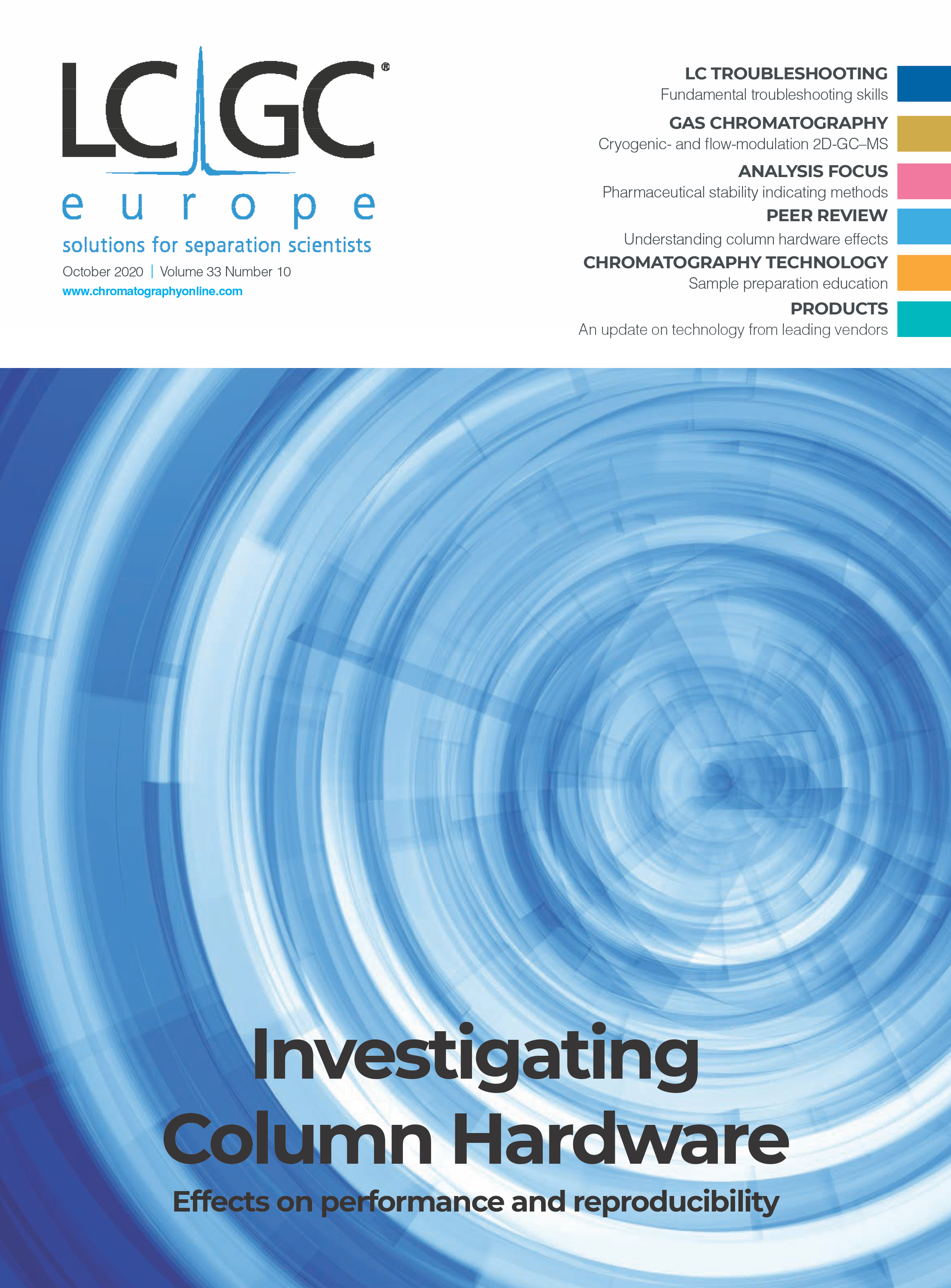
Extracting Estrogenic Hormones Using Rotating Disk and Modified Clays
April 14th 2025University of Caldas and University of Chile researchers extracted estrogenic hormones from wastewater samples using rotating disk sorption extraction. After extraction, the concentrated analytes were measured using liquid chromatography coupled with photodiode array detection (HPLC-PDA).
Polysorbate Quantification and Degradation Analysis via LC and Charged Aerosol Detection
April 9th 2025Scientists from ThermoFisher Scientific published a review article in the Journal of Chromatography A that provided an overview of HPLC analysis using charged aerosol detection can help with polysorbate quantification.
Removing Double-Stranded RNA Impurities Using Chromatography
April 8th 2025Researchers from Agency for Science, Technology and Research in Singapore recently published a review article exploring how chromatography can be used to remove double-stranded RNA impurities during mRNA therapeutics production.






